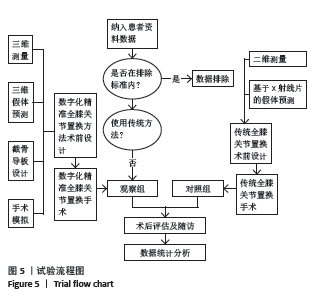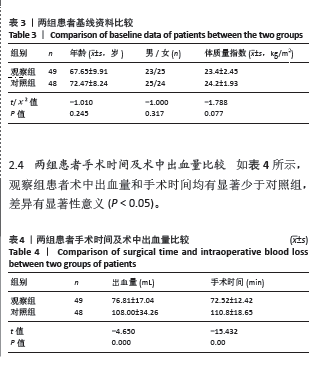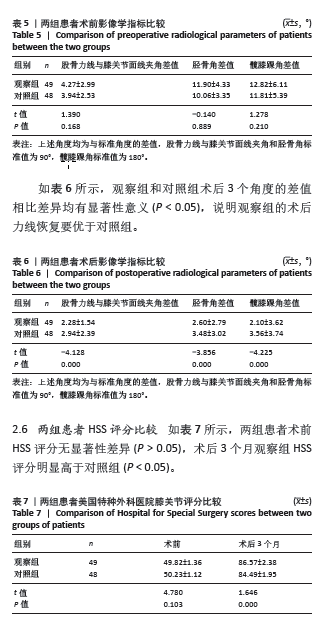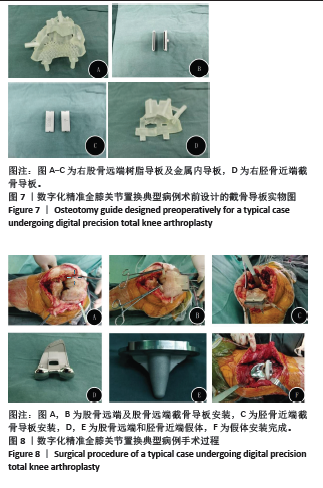[1] SADOGHI P, LIEBENSTEINER M, AGREITER M, et al. Revision surgery after total joint arthroplasty: a complication-based analysis using worldwide arthroplasty registers. J Arthroplasty. 2013;28(8):1329-1332.
[2] KARASAVVIDIS T, PAGAN MOLDENHAUER CA, LUSTIG S, et al. Definitions and consequences of current alignment techniques and phenotypes in total knee arthroplasty (TKA) - there is no winner yet. J Exp Orthop. 2023;10(1):120.
[3] LE DH, GOODMAN SB, MALONEY WJ, et al. Current modes of failure in TKA: infection, instability, and stiffness predominate. Clin Orthop Relat Res. 2014;472(7):2197-200.
[4] CHEN JW, KUO FC, KUO SJ, et al. Avoidance of intramedullary violation in computer-assisted total knee arthroplasty lowers the incidence of periprosthetic joint infection compared with conventional total knee arthroplasty: A propensity score matching analysis of 5342 cases. Knee. 2022;35:164-174.
[5] 张进, 孙立, 杨先腾, 等. 数字化模拟技术应用于全膝关节置换术前假体尺寸预测的临床探讨[J]. 上海交通大学学报 (医学版),2016,36(9): 1292-1296.
[6] KESKINIS A, PARASKEVOPOULOS K, DIAMANTIDIS DE, et al. The Role of 3D-Printed Patient-Specific Instrumentation in Total Knee Arthroplasty: A Literature Review. Cureus. 2023;15(8):e43321.
[7] 陈拥,王增辉,朴成哲.3D打印个性化截骨导板辅助行全膝关节置换的应用[J].中国组织工程研究,2019,23(8):1155-1160.
[8] 高嘉翔, 邢丹, 林剑浩. 下肢力线的测量及其在全膝关节置换术中的应用[J]. 中华外科杂志,2020,58(6):478-480.
[9] 石威,严伟,余昕,等.3D打印截骨导板辅助人工全膝关节置换术在重度膝内翻畸形中的应用观察.蚌埠医学院学报,2022,47(10):1401-1406.
[10] ZHENG K, SUN H, ZHANG W, et al. Mid-Term Outcomes of Navigation-Assisted Primary Total Knee Arthroplasty Using Adjusted Mechanical Alignment. Orthop Surg. 2023;15(1):230-238.
[11] NAM D, MCARTHUR BA, CROSS MB, et al. Patient-specific instrumentation in total knee arthroplasty: a review. J Knee Surg. 2012;25(3):213-219.
[12] BLAGOJEVIC M, JINKS C, JEFFERY A, et al. Risk factors for onset of osteoarthritis of the knee in older adults: a systematic review and meta-analysis. Osteoarthritis Cartilage. 2010;18(1):24-33.
[13] ONUORA S. Osteoarthritis: Arthroscopy does not delay TKA for knee OA. Nat Rev Rheumatol. 2018;14(2):62.
[14] LE STUM M, GICQUEL T, DARDENNE G, et al. Total knee arthroplasty in France: Male-driven rise in procedures in 2009-2019 and projections for 2050. Orthop Traumatol Surg Res. 2023;109(5):103463.
[15] ERIVAN R, TARDIEU A, VILLATTE G, et al. Knee surgery trends and projections in France from 2008 to 2070. Orthop Traumatol Surg Res. 2020;106(5):893-902.
[16] MARADIT KREMERS H, LARSON DR, CROWSON CS, et al. Prevalence of Total Hip and Knee Replacement in the United States. J Bone Joint Surg Am. 2015;97(17):1386-1397.
[17] HAWKER GA, BOHM E, DUNBAR MJ, et al. The Effect of Patient Age and Surgical Appropriateness and Their Influence on Surgeon Recommendations for Primary TKA: A Cross-Sectional Study of 2,037 Patients. J Bone Joint Surg Am. 2022;104(8):700-708.
[18] 刘发泰, 杨进顺, 钟伟斌. 3D 截骨导板在合并股骨畸形膝关节骨性关节炎患者膝关节置换中的应用[J]. 中国组织工程研究,2022,26(15): 2312-2316.
[19] PARK A, NAM D, FRIEDMAN MV, et al. Inter-observer precision and physiologic variability of mri landmarks used to determine rotational alignment in conventional and patient-specific TKA. J Arthroplasty. 2015; 30(2):290-295.
[20] HOORNTJE A, WITJES S, KOENRAADT KLM, et al. More Severe Preoperative Kellgren-Lawrence Grades of Knee Osteoarthritis were Partially Associated with Better Postoperative Patient-Reported Outcomes in TKA Patients. J Knee Surg. 2019;32(3):211-217.
[21] 郭盛杰, 张洪, 李玉军, 等. 全膝关节置换术前模板测量预测术中假体型号: 92 例资料回顾[J]. 中国组织工程研究与临床康复,2007,11(40): 8070-8073.
[22] CARPENTIER A, LOULMET D, AUPECLE B, et al. Computer-assisted cardiac surgery. Lancet. 1999;353(9150):379-380.
[23] RADTKE A, SOTIROPOULOS GC, MOLMENTI EP, et al. Computer-assisted surgery planning for complex liver resections: when is it helpful? A single-center experience over an 8-year period. Ann Surg. 2010;252(5):876-883.
[24] MERLOZ P, TONETTI J, PITTET L, et al. Computer-assisted spine surgery. Comput Aided Surg. 1998;3(6):297-305.
[25] BÄTHIS H, PERLICK L, TINGART M, et al. Alignment in total knee arthroplasty. A comparison of computer-assisted surgery with the conventional technique. J Bone Joint Surg Br. 2004;86(5):682-687.
[26] HEINZ T, EIDMANN A, ANDERSON P, et al. Trends in Computer-Assisted Surgery for Total Knee Arthroplasty in Germany: An Analysis Based on the Operative Procedure Classification System between 2010 to 2021. J Clin Med. 2023;12(2):549.
[27] STÜBIG T, WINDHAGEN H, KRETTEK C, et al. Computer-Assisted Orthopedic and Trauma Surgery. Dtsch Arztebl Int. 2020;117(47):793-800.
[28] SINGLA A, MALHOTRA R, KUMAR V, et al. A Randomized Controlled Study to Compare the Total and Hidden Blood Loss in Computer-Assisted Surgery and Conventional Surgical Technique of Total Knee Replacement. Clin Orthop Surg. 2015;7(2):211-216.
[29] GAUKEL S, VUILLE-DIT-BILLE RN, SCHLÄPPI M, et al. CT-based patient-specific instrumentation for total knee arthroplasty in over 700 cases: single-use instruments are as accurate as standard instruments. Knee Surg Sports Traumatol Arthrosc. 2022;30(2):447-455.
[30] WU Q, YU T, LEI B, et al. A New Individualized Three-Dimensional Printed Template for Lateral Ankle Ligament Reconstruction. Med Sci Monit. 2020; 26:e922925.
[31] ROSSI R, COTTINO U, BRUZZONE M, et al. Total knee arthroplasty in the varus knee: tips and tricks. Int Orthop. 2019;43(1):151-158.
[32] REZAEI A, MOON J, LICHTIG A, et al. Precision soft tissue balancing: grid-assisted pie-crusting in total knee arthroplasty. Front Surg. 2024;11: 1331902.
[33] FOO WYX, CHEN JY, PANG HN, et al. Severe genu varus deformity does not affect enhanced recovery after surgery total knee arthroplasty outcomes. Arch Orthop Trauma Surg. 2024. doi: 10.1007/s00402-024-05280-y.
[34] UMRE A, WAKDE O, MEGHARE R. Are soft tissue releases sufficient to correct moderate to severe flexion contractures during total knee replacement? Role of hamstring tenotomy and horizontal capsular release. Knee. 2022;39:291-299.
[35] XU HT, DONG JT, WANG J, et al. Surgical Technique of Total Knee Arthroplasty without Soft Tissue Balance. Orthop Surg. 2016;8(4):519-522.
[36] HAMILTON DA, ONONUJU U, NOWAK C, et al. Differences in Immediate Postoperative Outcomes Between Robotic-Assisted TKA and Conventional TKA. Arthroplast Today. 2021;8:57-62.
[37] ROMAN MD, RUSSU O, MOHOR C, et al. Outcomes in revision total knee arthroplasty (Review). Exp Ther Med. 2022;23(1):29.
[38] VAIDYA NV, DESHPANDE AN, PANJWANI T, et al. Robotic-assisted TKA leads to a better prosthesis alignment and a better joint line restoration as compared to conventional TKA: a prospective randomized controlled trial. Knee Surg Sports Traumatol Arthrosc. 2022;30(2):621-626.
[39] LADDHA M, GAURAV S. Assessment of Limb Alignment and Component Placement After All Burr Robotic-Assisted TKA. Indian J Orthop. 2020; 55(Suppl 1):69-75.
[40] CLATWORTHY M. Patient-Specific TKA with the VELYS™ Robotic-Assisted Solution. Surg Technol Int. 2022;40:315-320.
[41] INDELLI PF, SALVI AG, PETRALIA G. Editorial: Alignment options and robotics in total knee arthroplasty (TKA) “Alignment, alignment, alignment, but TKA fail mainly for infections and instability”. Front Surg. 2023;10:1247759.
[42] WINNOCK DE GRAVE P, KELLENS J, et al. Clinical outcomes in TKA are enhanced by both robotic assistance and patient specific alignment: a comparative trial in 120 patients. Arch Orthop Trauma Surg. 2023;143(6): 3391-3399. |





